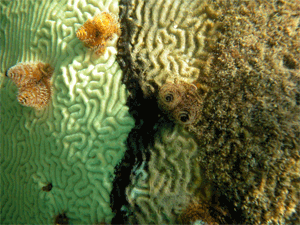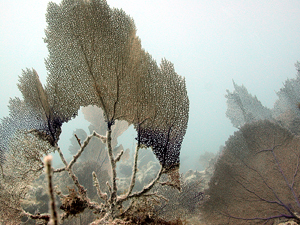Causes of Coral Disease
The causes of coral disease outbreaks are complex and not well understood, although research suggests that important drivers of coral disease include climate warming, and other anthropogenic stressors such as land-based pollution, sedimentation, overfishing, and human use. Scientists are learning more about the causes of coral disease, especially in terms of identifying the pathogens involved. Biotic coral diseases are caused by a multitude of micro and macro-organisms including pathogenic bacteria, ref cyanobacteria-dominated microbial consortiums, ciliates and parasites. ref To date, the most infectious coral diseases are caused by bacteria.
Significant relationships exist between coral disease prevalence and elevated water temperatures, ref decline in water quality, ref vector and host densities, ref and intensity of coral bleaching.
Use the tabs below to learn more about modes of transmission and environmental drivers of coral diseases.
Several mechanisms and environmental conditions support disease transmission, including areas of high coral cover, water quality, and certain predators (e.g., some corallivorous fish, polychaetes, and gastropods). ref It is important for managers to be aware of the various modes of disease transmission, as these inform monitoring efforts which ultimately help to guide management strategies.

Black band disease advancing from right to left in the coral Diploria strigosa. Photo © Sven Zea, Universidad Nacional de Colombia/Marine Photobank
Similar to human populations, coral species with higher local abundances may be more susceptible to disease.ref For example, the coral disease white syndrome has increased in areas where coral cover is high.ref This is because disease can spread more readily within crowded populations. Therefore, common coral species may have a greater disease potential than rare species. ref
Coral predation is another mechanism that may facilitate disease transmission in dense coral populations. Predators can act as vectors by oral or fecal transmission of pathogens. ref For example, black band disease is thought to flourish in the presence of corallivorous fishes.ref Other corallivores, such as the gastropod Drupella spp., are suspected to increase the rate at which the disease is spread from infected to non-infected colonies. ref Other coral-disease vectors are the fireworm, Hermodice carunculata, whose gut has been found to harbor Vibrio shiloi (the pathogen inducing bacterial bleaching in some Mediterranean coral) ref and butterflyfish, which harbor a trematode (parasitic flatworm) that infects Porites. ref
Environmental drivers, such as temperature, water quality, and sedimentation, can significantly affect disease outbreaks. ref
Temperature
Warming sea surface temperatures is thought to influence coral diseases in two ways:
- Encouraging infectious diseases by impairing the defense mechanisms of the coral host. Increased temperatures can affect basic biological and physiological properties of corals, particularly their ability to fight infection. This has an influence on the balance between potential pathogen and host.ref
- Increasing the virulence or growth rate of disease-causing organisms.ref

Aspergillosis affecting sea fan corals Gorgonia ventalina in the Florida Keys. Photo © Craig Quirolo/Reef Relief
Seasonal patterns in disease prevalence provide further support for a link between warming ocean waters and disease outbreaks. For example, on the Great Barrier Reef, coral disease prevalence increased from winter to summer in all major families of coral. Links between outbreaks or the increasing prevalence of disease and warm temperature have been detected for black band disease, aspergillosis, yellow band disease, white patch disease and white syndrome.
Water Quality
Coral disease is also facilitated by a decrease in water quality, particularly due to eutrophication and sedimentation. Recent evidence suggests a synergistic effect between elevated nutrients and disease. High nutrient levels (e.g., nitrogen and phosphorus) have been associated with accelerated disease signs in both yellow band disease- and aspergillosis-infected corals in field manipulations ref and in black band disease. ref
Sedimentation
Sedimentation may also contribute to coral disease outbreaks. The impacts of land-based sedimentation on near-shore coral communities are visible and well documented; corals inhabiting silted reefs often possess large patches of dead, exposed skeleton bordered by receding margins of healthy tissue. Opportunistic land-based pathogens (the soil fungus Aspergillus sydowii and the human bacterium Serratia marcescens) have been identified as causal agents for coral diseases in the Caribbean. ref
By addressing anthropogenic threats (reduced water quality and increased sedimentation) through improved coastal zone management practices, managers can reduce factors that contribute directly to coral disease.
